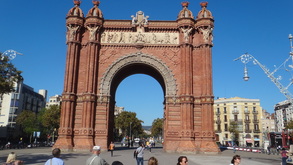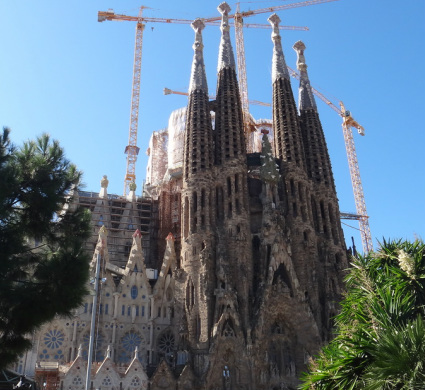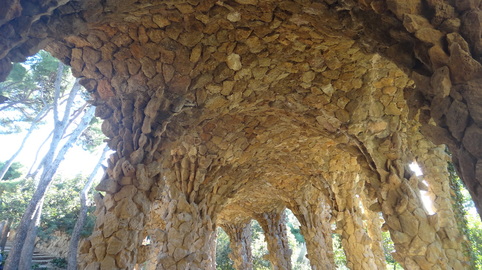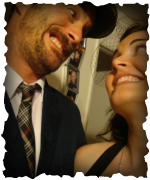
We arrived in Barcelona late in the afternoon, and the first thing that struck me was the airport. I didn't know what to expect with Barcelona. I'd never seen pictures or conjured up images of what it would be like. But, I was really impressed.
The airport was clean, modern, and cultural. That ended up being a good pulse of the Barcelona experience. I loved the airport, and we'd seen quite a few!
We took a bus (again, very clean and modern) to meet our host, Francois, and his girlfriend. They had a lovely apartment in a place with a doorman (new for us!), and they were so wonderful to us. I had fun trying to practice my French with Francois, and Chris utilized his Spanish with both of them.
It rained hard that first night and the next day. We had our first tapas dinner (at about 9pm, which is normal there) and then just headed back. The second day, we walked around a bit, shopped, tried more food, and found a great, cheap place for breakfast pastries. Yum! We also found out that the subway system was really simple to navigate.
On our second day, we wanted to try out the Fat Tire Bike Tour once again (the first time was in Paris). It was so fun and informative! Our first stop was the Arc de Triomphe. Yes, Barcelona has an Arc de Triomphe, too. Not just Paris, where it's best known! But, several cities actually had an Arc de Triomphe to parade their returning soldiers through when victorious.
The Barcelona city council had plans to build another structure in that spot, but the citizens were so distraught about the idea and forced another decision. The Arc was plan B. What was the city council's original plan, you might ask? Oh, it was just a tower by Gustav Eiffel. He said "no problem" and went to the Paris city council, where it was ultimately built.
We also learned that Barcelona isn't technically in Spain. It's actually the capital of Catalonia, and that's actually a really big deal. The Spanish and the Catalans have long been feuding, and the Catalans view themselves as autonomous from Spain. There's even a Catalan language, although it was suppressed by the Spanish after they won the revolution. Learning things like this made us feel glad we now knew it, but a little stupid for not knowing it before.
The palace was really cool (I love a good palace!) where Ferdinand II of Aragon Isabella I of Castille resided in 1469, and then we got our first taste of Gaudi. There is this gorgeous park, Parc de la Ciutadella, with ornate fountains and a zoo. They like to claim Gaudi helped design the fountains, which he kind of did, but he was only an apprentice then. So, he basically just helped build what was instructed.
The airport was clean, modern, and cultural. That ended up being a good pulse of the Barcelona experience. I loved the airport, and we'd seen quite a few!
We took a bus (again, very clean and modern) to meet our host, Francois, and his girlfriend. They had a lovely apartment in a place with a doorman (new for us!), and they were so wonderful to us. I had fun trying to practice my French with Francois, and Chris utilized his Spanish with both of them.
It rained hard that first night and the next day. We had our first tapas dinner (at about 9pm, which is normal there) and then just headed back. The second day, we walked around a bit, shopped, tried more food, and found a great, cheap place for breakfast pastries. Yum! We also found out that the subway system was really simple to navigate.
On our second day, we wanted to try out the Fat Tire Bike Tour once again (the first time was in Paris). It was so fun and informative! Our first stop was the Arc de Triomphe. Yes, Barcelona has an Arc de Triomphe, too. Not just Paris, where it's best known! But, several cities actually had an Arc de Triomphe to parade their returning soldiers through when victorious.
The Barcelona city council had plans to build another structure in that spot, but the citizens were so distraught about the idea and forced another decision. The Arc was plan B. What was the city council's original plan, you might ask? Oh, it was just a tower by Gustav Eiffel. He said "no problem" and went to the Paris city council, where it was ultimately built.
We also learned that Barcelona isn't technically in Spain. It's actually the capital of Catalonia, and that's actually a really big deal. The Spanish and the Catalans have long been feuding, and the Catalans view themselves as autonomous from Spain. There's even a Catalan language, although it was suppressed by the Spanish after they won the revolution. Learning things like this made us feel glad we now knew it, but a little stupid for not knowing it before.
The palace was really cool (I love a good palace!) where Ferdinand II of Aragon Isabella I of Castille resided in 1469, and then we got our first taste of Gaudi. There is this gorgeous park, Parc de la Ciutadella, with ornate fountains and a zoo. They like to claim Gaudi helped design the fountains, which he kind of did, but he was only an apprentice then. So, he basically just helped build what was instructed.

Then, we stopped at the Barcelona beach for sangria and drinks. That was a surreal experience just lounging at a beach cafe with other tourists. We didn't really interact with many other tourists in our travels, so it was interesting to hear their stories and plans while sharing a pitcher of sangria.
The beaches are entirely man-made, created for use during the 1992 Summer Olympics in Barcelona. So beautiful, and a sunny break from the downpours we had experienced!
Now let's get back to Gaudi. We, of course, stopped by the Sagrada Familia--Gaudi's masterpiece. Gaudi, born in 1852, was a Catalan architect who helped forge modernist design. He paid tremendous attention to details and angles, and created several new types of materials, including a ceramic pieced-together collage. Gaudi had a passion for religion and the people of Catalonia.
He died during the creation of the "Cathedral for the Poor" (Sagrada Familia)--his intended masterpiece--and raised money from wealthy citizens. The church remains unfinished, and Gaudi's written plans were burned, but construction is underway for completion in 2026. Despite Gaudi's many attempts to get Roman Catholic backing and support, which were rejected, Pope Benedict decided to consecrated the famous church in 2010. He said that before the consecration, the "basilica" had just been a pile of rocks, and not it was a church. That didn't go over too well with the Catalans.
Gaudi's design, and this structure in particular, was unlike anything I'd ever seen before. Bright colors, creative textures, and inventive designs--not to mention the enormous size--made me awestruck. And although Gaudi followers are supposedly following through with his intended plans for completion, the new construction looks entirely different. That was bizarre and a little startling to see the sharp differences.
The beaches are entirely man-made, created for use during the 1992 Summer Olympics in Barcelona. So beautiful, and a sunny break from the downpours we had experienced!
Now let's get back to Gaudi. We, of course, stopped by the Sagrada Familia--Gaudi's masterpiece. Gaudi, born in 1852, was a Catalan architect who helped forge modernist design. He paid tremendous attention to details and angles, and created several new types of materials, including a ceramic pieced-together collage. Gaudi had a passion for religion and the people of Catalonia.
He died during the creation of the "Cathedral for the Poor" (Sagrada Familia)--his intended masterpiece--and raised money from wealthy citizens. The church remains unfinished, and Gaudi's written plans were burned, but construction is underway for completion in 2026. Despite Gaudi's many attempts to get Roman Catholic backing and support, which were rejected, Pope Benedict decided to consecrated the famous church in 2010. He said that before the consecration, the "basilica" had just been a pile of rocks, and not it was a church. That didn't go over too well with the Catalans.
Gaudi's design, and this structure in particular, was unlike anything I'd ever seen before. Bright colors, creative textures, and inventive designs--not to mention the enormous size--made me awestruck. And although Gaudi followers are supposedly following through with his intended plans for completion, the new construction looks entirely different. That was bizarre and a little startling to see the sharp differences.

Later that afternoon, we went to the "Gothic Quarter," and that was spectacular. That's the old city center of Barcelona, with buildings dating back to medieval times. Near that area is a lot of shopping--I looked in more stores there than anywhere else during the trip combined! Finally, we had dinner at an outdoors tapas place nearby.
The next morning, we wanted to visit the Park Guell before our train left for Madrid. This was another Gaudi creation (there are several) dedicated to his prime benefactor, Eusebi Guell. It was like a little village and it felt very inspiring. We got to the park just before it opened, so we had about 5 minutes of peace until the tour buses arrived and hundreds of people poured out.
Gaudi's home was nearby, so we walked there. In case you can't tell, I found Gaudi's designs really fascinating, and Gaudi was so meticulous that he even designed the walkways!
We had a fantastic time in Barcelona, and then we headed to our last stop...Madrid.
The next morning, we wanted to visit the Park Guell before our train left for Madrid. This was another Gaudi creation (there are several) dedicated to his prime benefactor, Eusebi Guell. It was like a little village and it felt very inspiring. We got to the park just before it opened, so we had about 5 minutes of peace until the tour buses arrived and hundreds of people poured out.
Gaudi's home was nearby, so we walked there. In case you can't tell, I found Gaudi's designs really fascinating, and Gaudi was so meticulous that he even designed the walkways!
We had a fantastic time in Barcelona, and then we headed to our last stop...Madrid.




 RSS Feed
RSS Feed